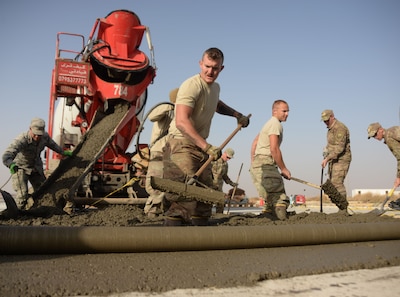By Air Force Senior Master Sgt. Cohen Young, 332nd Air
Expeditionary Wing
SOUTHWEST ASIA, Dec. 13, 2017 — A team of 322nd Expeditionary
Civil Engineering Squadron airmen spanning six specialties has taken on an
extensive runway repair project to protect aircraft from potential foreign
object damage -- known on flight lines as FOD.
“We had a lot of damaged concrete which could affect the
aircraft,” said Air Force Staff Sgt. Christopher Larson, a pavement equipment
construction operator. “That’s a big part of our job out here on the runway --
to reduce FOD. We’re repairing the runway to make it suitable for the
aircraft.”
The runway gets heavy use by coalition partners flying
missions in support of Operation Inherent Resolve, the effort to defeat the
Islamic State of Iraq and Syria.
“This airfield has been used heavily lately, as we’ve been
flying a lot of sorties giving ISIS a little bit of trouble and keeping them up
at night, so we need this airfield in order to sustain this operation,” added
Larson, a North Dakota Air National Guardsman. “The C-17s, C-130s, F-15s, F-16s
and our coalition partners are flying hot and heavy out of this airfield.”
Difficult Project
The project is not an easy one, because the airmen can only
lay the concrete first thing in the morning, due to resources and weather, so
they do a little bit each day. The project has been going on for two weeks, and
the team has completed much of the current airfield.
“We laid 900 to 1,000 yards of concrete, repaired 60
dilapidated slabs, and over 425 spalls,” said Air Force Senior Master Sgt.
Nathan Laidlaw, superintendent of heavy equipment repair. The project calls for
a lot of labor and a specific skill set that wasn’t readily available in
numbers, he noted.
The 332nd ECES doesn’t have many heavy equipment operators,
so Laidlaw built his team from available resources, using plumbers, heating
ventilation and air conditioning technicians and power production technicians
to accomplish the sizeable task and complete the mission.
Team Effort
“We’re a conglomerate of active duty and National Guardsmen
working together on this project,” Laidlaw said. “Due to a lack of ‘dirt boys’
on this jobsite, we have HVAC, power pro, plumbers, you name it. We came
together as a team and trained together as a team, and we’re completing this
together as one.”
“We blended together,” said Air Force Tech. Sgt. Erin
Eagleson, a quality control technician from Minot, North Dakota. “It’s great --
you don’t realize if someone is active duty or guard or from one unit to
another unit.”
Before the team could start laying the concrete, the airmen
had to test the material for fluidity, workability and strength.
“We performed slump tests and made concrete cylinders to
test the [pounds per square inch] of the concrete,” Eagleson said. “We do this
to measure the moisture content in the concrete. … The more water in your
concrete, the higher your slump number will be.”
Eagleson tests two samples from each truck to ensure
quality. She’s the quality control expert and ensures the concrete will be
strong enough.
“We test a cylinder at seven days and at 28 days,” she said.
“This gives us the strength of the concrete, and it should be at 50 percent at
seven days, and at 28 days, it should be measuring at 6,000 psi, which would be
a 100 percent.”
There’s a bit of pride in every member of the team as they
strive to do their part. “It means a lot to everyone to make sure we get these
planes back in the air,” Laidlaw said.







No comments:
Post a Comment